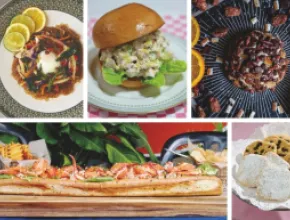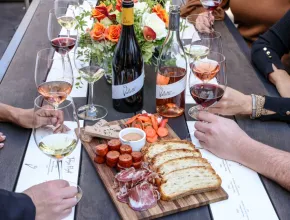1. Can you explain attrition and enhancing your meals?
Once you have given your guarantee to a facility, you are charged for those meals, whether they are consumed or not. Use your history and program to try to reach the guarantee, which reduces the possibility of attrition. This is based upon your experience as a meeting professional. Meals are enhanced by working with the chef to determine how to get the best value for your F&B dollar. What can be added at minimal or no cost?
2. Can you explain service charges in more detail?
Facilities add a service charge above the cost of the meal. According to PCMA’s 5th edition of Comprehensive Strategies for Meetings, Conventions and Events, “service charges added to the bill will range from 18%-22% (now could be up to 24% BW) of total. Hotels will retain a portion of the service charge.” State laws will determine whether the service charge is taxed or whether a service charge is added and then tax is added individually. In some cases, service charges are made on taxes. It is important that you ask how service charges and taxes are calculated. I hope that this is helpful.
3. Most hotels will not allow you to take food off premises. If that is the case, how can we provide bags for people to take their lunch or anything else to go?
I've had hotels provide box lunches for bus tours many times. I would say that they don't allow food to be brought on-premises...but I've never had the question about taking it off-premises. Most times, the food will be consumed right away. Local laws vary according to whether people can take food outside a facility. My experience has been that when I’ve discussed my request with chefs or convention service managers in advance of my event, they have been willing to arrange food to be taken out. It is expensive to provide boxed meals because of the manpower, but you can arrange a fast-moving buffet line where attendees take sandwiches (which could be cut in halves) plus fresh fruit, plus chips in bags, and a bottled or canned drink to place in bags to go. The food should be set inside, particularly during hot weather, and products such as mayonnaise might not be included in the sandwich. There is a Good Samaritan law that limits liability for facilities that donate food. Charities might have to pick up food themselves from the facilities. This should be discussed during the negotiation process.
4. It seems very difficult to get some protein worked into an affordable breakfast. The options tend to be loaded with gluten and sugar, such as pastries. Any suggestions?
Consider adding hard-boiled eggs, cheeses and yogurt to a continental breakfast. Breakfast pastries could include fruit and bread such as banana bread or English muffins rather than croissants and Danish.
5. Is there an electronic publication/guide that provides a rule of thumb as to what the average cost per head count is for breakfast, for lunch and for dinner during an event at, say, a three-star hotel, a four-star hotel, etc.?
The cost of a menu is determined by the facility selected and the geographical location. Are you meeting in a first-tier city such as New York City or San Francisco, or a second-tier city such as Charlotte or Nashville? What is the profile of the attendees? What is the history of your group? How does the F&B event fit into the program? Also, what menu are you selecting? There is a major difference in offering filet mignon or an upgraded salad. Are you offering an upgraded continental breakfast or a full breakfast with omelet stations? Will alcoholic beverages be served at your function? What is the portion size? Much more information is needed to respond to your question. PageBreak
6. If you decide to serve different menus in different sections of the room, how do you determine the number of seats in each section? I imagine one will be more popular than another?
PCMA experimented with the quadrants for lunch at their annual meeting for 3000-plus people. It is difficult to determine exactly how many seats you need in each area. It will be helpful to know the profile of your attendees to determine which menus would be most popular for your group. Ideally, there would be roughly the same number of people in each quadrant. For the PCMA function, seating was based upon availability with first arrivals making their selections. I would imagine that some attendees did not get their first choice.
7. Have you come across with health concerns with family-style service? My attendees are doctors and I think they may think this is unsanitary?
I have not come across concerns about family-style serving being unsanitary. Food is placed on the tables with serving utensils, attendees serve themselves with the serving utensils and don’t use their own forks or spoons. You could have wait staff serve the food from the serving platters rather than have attendees serve themselves.
8. Is there a rule if the service charges are taxed or not?
The taxation on service charges is determined by state law and varies from state to state.
9. What about additional savings with meeting room Internet? Not so much F&B but additional audiovisual charges seem to just grow?
As you prepare your RFP (request for proposal), create a list of “must haves” and “would like to haves.” Where does the Internet fit on your lists? Negotiate the costs of your Internet and audiovisual services during your site selection process. Compare costs of using the in-house AV company vs. contracting with an outside AV firm. Consider bringing in your own extension cords, flip charts and markers. Include everything that you negotiate in your written contract.
10. How do you eliminate canned sodas as an option?
Offer water with fruit at water stations or non-alcoholic punch with glasses. If canned soft drinks are offered, attendees can take soft drinks back to their rooms and this increases your consumption and costs.
PageBreakBonus Questions!
When budgeting, is it easier to work with a per-person rate or a set overall number?
Determining whether a per-person rate or a set overall number prevails depends on the profile of your group, your budget and the objectives of your meeting. If you have a history of previous meetings, this can help you make your decision. If you do not have a history, it’s not too late to start now by keeping track of your F&B orders compared with consumption and costing. You may need to experiment to come up with the best solution for your group.
Can you expand on the food truck concept? How is that used to feed large groups?
Food trucks can be used to feed large groups. Order foods that can be quickly served and limit the choices that are offered. The food trucks can be supplemented by food stations.
Any guidelines on ordering wines; the amount of red vs. white, etc.?
You must know the profile of your group and your history. If you serve a bottle of red wine and a bottle of white wine on each table, walk around to see which wine is being consumed. Take bottles that are not being consumed and exchange it with bottles at other tables to reduce over ordering. Pay by consumption of bottles ordered.
The convention services manager is usually a gatekeeper to the other hotel departments. How do you work around them without overstepping what they do?
I do not try to circumvent the convention service manager, but I include that person in my discussions with the chef. Our objectives should be the same: a successful event that reflects well on the facility, client (internal or external) and the meeting planner.
We always ask about special dietary restrictions. But what if a person doesn't complete the form or tell us about it? How do you handle it on-site at the event? Are kitchens prepared for last-minute dietary changes?
In an ideal world, we try to get as much information as possible in advance. In reality, some of our participants wait until the last minute to share their special needs, and you can only try to make your best effort with limited notice. I always ask the chef to prepare some special vegan meals, just in case we have last-minute requests. Other requests may not be able to be accommodated as easily. If someone is Kosher, it is difficult to arrange for a Glatt Kosher meal at the last minute. Knowing the profile of your attendees is important. Wherever possible, I prefer that the chef does not cook food in peanut oil or include nuts as an integral part of the meal in case there are people with allergies.
Would you ever do a combination hosted and cash bar, in which you give out two drink tickets, then they have to pay for additional drinks?
Combining a hosted bar with a cash bar is a great idea that I have used before. Provide tickets to your participants for a limited number of drinks, one or two depending upon the timing of the reception, and then participants pay for additional drinks on their own. PageBreak
I'm doing a reception at a convention center for 800 people. How do I gauge the number of servers for butler-passed food?
Once you meet with the banquet manager or chef, determine how much food you will be providing, the timing of the passing of the hors d’oeuvres, and your budget. The facility will advise you how many servers are needed.
Do you have a master checklist of elements to be considered when planning a meal function that can be shared?
PCMA, MPI and CIC (Convention Industry Council) have books that contain checklists for F&B. Check out their websites, as well as APEX, or you can order their books as a resource.
When a chef approaches you at a reception and tries to get you to purchase more food, how do you handle this situation if you are unsure if it is really needed?
I recommend meeting with a chef prior to a function to develop a relationship of trust and partnership on your F&B functions. The chef’s goals should be to have a successful function and to bring back repeat business. In the situation that you inquired about, determine how much longer the reception is lasting, how much food is left, and observe your attendees. Based upon the chef’s recommendations and your budget--can you afford to bring in more food?--and then you make your decision.
I want to plan a poster session with lunch. How should I set tables and what food should I serve to maximize attendees viewing posters and interacting with presenters.
You might consider providing a lunch buffet with food being offered at different stations so that your attendees move around the room. They can be seated at rounds or at rectangular tables. The menu is determined by your budget, profile of attendees, and the timing for the session. You would not have interactive food stations…people should get their food quickly to provide time for circulating around the posters.
We use drink tickets for our association's reception. Drink tickets are usually $7 each. This year's hotel is quoting $8.50, which is too high and they won't negotiate. Any suggestions?
I spoke with a catering director from a high-end hotel and she suggested that you discuss the kinds of liquor being served for the drink tickets. Do you expect high-end liquor? Will you be using the same tickets for beer, wine and hard liquor? What size of glasses are you using? Perhaps you could use color-coded tickets to differentiate the drinks. Review the objectives of your F&B function, the profile of your attendees, the program, your budget and your history. If your contract with the facility is already signed, is this the time to consider a cash bar for your association’s event? Once your contract with the facility is signed. Your options for negotiations are far more limited. Prior to signing a contract, you are negotiating. Once the contract is signed and you want to make changes, you are begging. You may have little leverage with this event but you may choose to go somewhere else for future events.
Can hotels donate leftover food to food banks?
The Good Samaritan law helps protect facilities that donate food. Some charities will pick up the food themselves. Check state and local laws regarding donating food. PageBreak
How do you get a hotel or caterer to go along with things like use leftover juice for smoothies when they have such strict rules about leftovers? Also, how do you get hotel chefs to work with you on recipes, etc., when they often only work through the CSM?
The juices that are left over from the breakfast can be used to make the morning or afternoon breaks. They are not being taken out of the facility. I have been successful working with the chefs. If they are not willing to work with you, then the catering manager must be very knowledgeable in partnering with you. Consider communicating by e-mail with all of your questions if they are not willing to meet with you personally. I have had great success in working with the chefs.
How would decide on food guarantees for each quadrant in advance? By quantity?
Let me start by emphasizing that it is important to know your program objectives, profile of attendees, and budget. In this situation where you are trying something unique, you must have the support of the facility that you are working with to insure that this goes smoothly. You have to consider your attendees in selecting potential menus for your group. In addition, Meetings a la Montreal and the Palais des Congress de Montreal were sponsoring the luncheon at PCMA at the Orlando Convention Center. You would have to guess how many people want to be seated in each quadrant and likely your guarantee might be higher for four quadrants than for just having one menu for the entire group. Also, having four different menus would be more costly than having just one menu. It’s possible that some people might have to take their second choice.
For a buffet, what is the best formula to use for guaranteeing the attendance? In other words, if you have 500 people, do you drop that number by 20 percent as the standard formula?
Order for the number of people who you expect will be attending. If you try to drastically under-order, you will run out of food. It will make both you and the facility look bad.
How much do you tip on your big groups 1,000 and over, low to high range?
I have spoken to a catering manager at a high-end hotel chain to get her opinion. There is not a set formula to use in gratuities. It depends upon the quality of service that you receive from the staff and your budget. Consider writing a letter to the general manager, or in one case, I wrote to Bill Marriott Jr., commending the exceptional service that I received from a member of his staff. Some facilities will provide incentives for their staff to offer outstanding service and they are recognized by their peers.
What kind of card do you recommend for allergy or special meals?
I recommend cards the size of standard business cards that could be color-coded or have pictures on them. For example, you might have a picture of a peanut with a slash through it for someone who is allergic to peanuts, a fish for someone who will be served fish, a chicken for someone who gets chicken, etc. It is critical that a “cheat sheet” be prepared and given to the F&B or catering manager, the chef and the convention service manager as well as a member of your staff who is supervising your F&B function. PageBreak
How do you guarantee head count when you set up a conference that is free of charge for the attendee? There are times when you get over 100 people registered but we know not all 100 will show. What is the best way to plan meals around that type of event?
Follow up prior to the event with reminders. People can easily respond and be no-shows if no payment is involved. Don’t guarantee for the number of people who respond and rely upon your history for your guarantees.
Is it normally more expensive to have a signature drink at a reception? If so, how do I negotiate that?
For signature drinks, is it more expensive than what? Signature drinks are more expensive than ordering just beer and wine but less expensive than having a complete bar.
If the client objects to drink tickets but has an open bar, what do you do then?
If the client does not want drink tickets, I don’t use them. It’s their meeting and as meeting professionals, we can make recommendations but it’s your client’s meeting.
By having different meals in the room, like at the recent PCMA Annual Conference in Orlando, wouldn't that increase your food budget by having more than just a few options?
Let me start by emphasizing that it is important to know your program objectives, profile of attendees and budget. In this situation, where you are trying something unique, you must have the support of the facility that you are working with to insure that this goes smoothly. You have to consider your attendees in selecting potential menus for your group. In addition, Meetings a la Montreal and the Palais des Congress de Montreal were sponsoring the luncheon at PCMA at the Orlando Convention Center. You would have to guess how many people want to be seated in each quadrant, and likely your guarantee might be higher for four quadrants than for just having one menu for the entire group. Also, having four different menus would be more costly than having just one menu. It’s possible that some people might have to take their second choice.
I have a hard time pushing whole fruit for our functions, do you have any suggestions?
Presentation is a key in making fruit an attractive choice. Avoid fruits like oranges that are messy to eat. Sliced fruit is another option. Once again, make it appealing for people to select fruits.






